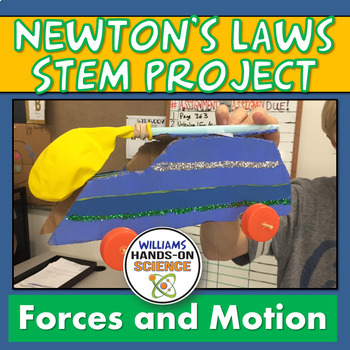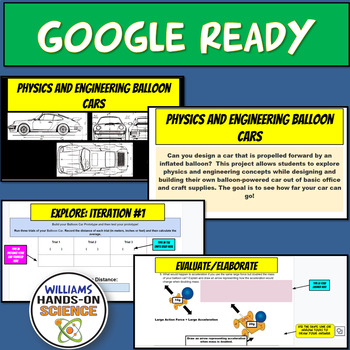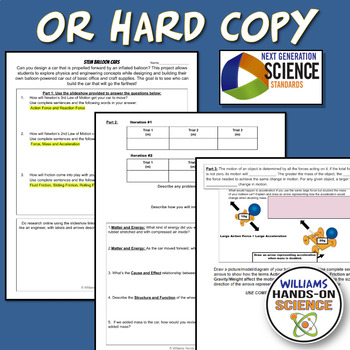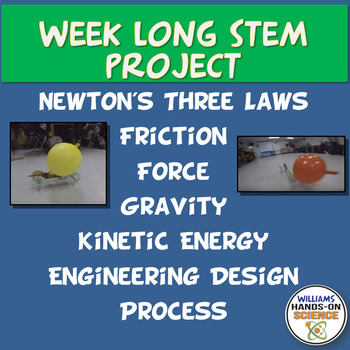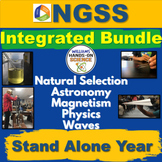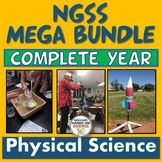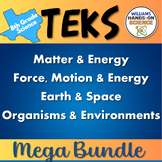End of Year STEM Project Forces Motion Newtons Laws 5E Balloon Cars NGSS Digital
- Zip
- Google Apps™

What educators are saying
Also included in
- Your students will remember these activities forever! These are student centered, challenging, hands-on, engaging activities that will wow and motivate even some of the most reluctant learners. I also include an editable unit test and a modified Special Education/English Language Learner test. I’vePrice $59.97Original Price $88.75Save $28.78
- Looking for a complete, standalone year-long curriculum for integrated NGSS Physics, Energy, Waves, Astronomy, Earth’s History, Science and Engineering Practices, Crosscutting Concepts, and Evolution? Look no further than this student-centered, inquiry-based, hands-on bundle! Designed to align withPrice $205.00Original Price $366.00Save $161.00
- This bundle is a time-saving, comprehensive and user-friendly complete year bundle for physical science Teachers that will streamline your teaching experience effortlessly! Every lesson is meticulously planned and just a click away. This extraordinary bundle is a treasure trove of engaging resourcesPrice $176.00Original Price $311.50Save $135.50
- The TEKS 8th Grade Bundle is a comprehensive resource for teaching science mainly in Texas, but it can be used in any state. This bundle includes over 60 hands-on, rigorous, engaging, and phenomena-driven lessons that cover the TEKS standards for 8th grade science. The lessons are designed to help sPrice $160.00Original Price $321.15Save $161.15
Description
5E NGSS Aligned Balloon Cars engages even the most apathetic students! Your students will remember this lesson forever! AND! It's very easy prep to make your job easy!
You get the following:
-Hard Copy Version
-Google Ready Version
-Teacher slides packed with tips, advice, classroom management and student instructions
-2 Assessments
-Key
Or buy my bundle that includes all of my physics products NGSS Physics Resource Bundle
If you need a whole bundle of Physics Distance Learning Resources take a look at Distance Learning PS2.A PS2.B NGSS Forces & Motion Growing Bundle Google Ready
Balloon Cars has the following NGSS Standards:
Performance Expectations and Disciplinary Core Ideas
MS-PS2-1. Apply Newton’s Third Law to design a solution to a problem involving the motion of two colliding objects.
MS-PS2-2. Plan an investigation to provide evidence that the change in an object’s motion depends on the sum of the forces on the object and the mass of the object.
For any pair of interacting objects, the force exerted by the first object on the second object is equal in strength to the force that the second object exerts on the first, but in the opposite direction (Newton’s third law). (MS-PS2-1)
The motion of an object is determined by the sum of the forces acting on it; if the total force on the object is not zero, its motion will change. The greater the mass of the object, the greater the force needed to achieve the same change in motion. For any given object, a larger force causes a larger change in motion. (MS-PS2-2)
All positions of objects and the directions of forces and motions must be described in an arbitrarily chosen reference frame and arbitrarily chosen units of size. In order to share information with other people, these choices must also be shared. (MS-PS2-2)
Motion energy is properly called kinetic energy; it is proportional to the mass of the moving object and grows with the square of its speed. (MS-PS3-1)
A system of objects may also contain stored (potential) energy, depending on their relative positions. (MS-PS3-2)
Science and Engineering Practices
Asking Questions and Defining Problems
Planning and Carrying Out Investigations
Constructing Explanations and Designing Solutions
Cross Cutting Concepts
Cause and Effect
Systems and System Models
The 5E’s
ENGAGE: Using the YouTube clips I created with past classes is great at engaging students and it captures the students’ attention and interest. It also helps to get the students focused on the purpose of the lab and the content. Here are the YouTube clips:
https://www.youtube.com/watchv=RxKwYB0uYh0
https://www.youtube.com/watch?v=_7kHs012tC0
EXPLORE #1: This is where the students have opportunities to resolve misconceptions of the engage section. This part gives students the hands-on experiences to demonstrate their knowledge of the engage phase. In this part they will conduct research and sketch their prototype like an engineer. In this part you will need to discuss parameters and rules (10 mins), Then do online research, discuss and agree on design, make sketches of parts and prototype, figure out who brings in what materials for the next class meeting (30 mins).
EXPLAIN: The scientific explanation for the physics behind the balloon car’s motion is the objective of this phase. The students should now have a clearer sense of the engage part and have higher comprehension of the concepts. They can do this by watching YouTube clips that explain the scientific principles behind Newton’s Laws of Motion or read online resources.
EXPLORE #2: This is where the students have opportunity to learn through building, testing, revising, brainstorming, remodeling and evaluating their prototype like engineers do. This exploration phase provides a concrete, hands-on experience where students use data to clarify the misconceptions of the engage phase.
ELABORATE/EVALUATE: Sometimes this phase is called Extend, but in this case Elaborate is more appropriate. This is where scientific concepts and abilities are extended, expanded and enriched. They will do this by applying the concepts and vocabulary to the motion of their balloon cars. I will then use this section to also
EVALUATE and assess what they’ve learned and what they still need to learn through the questions, the diagram, feedback and class discussions.
TERMS OF USE
• All rights reserved by Williams Hands On Science, Inc.
• This product is to be used by the original purchaser only.
• Intended for classroom and personal use only.
• Copying for more than one teacher, classroom, department, school, or school system is prohibited.
• This product may not be distributed or displayed digitally for public view.
• Failure to comply is a copyright infringement and a violation of the Digital Millennium Copyright Act (DMCA).
If there are any errors or questions, please contact me through TpT or email me at:
williamshandsonscience@gmail.com
Thank you for taking a look!
Please follow me on TpT for new products and check me out on Instagram for my products in action!
https://www.instagram.com/williams_hands_on_science/
Related Products
⭐ 10 Editable Motion Bell Ringer Warm Ups and Key
⭐ 5E NGSS Collision Lab: Relationship between Motion and Forces
⭐ Balloon Rockets Lab
⭐ Bell Ringer Warm Up: Force, Acceleration, Graphing & Energy
⭐ Bell Ringer Warm Up: Force, Acceleration, Graphing & Energy
⭐ Bell Ringer Warm Up: Speed, Acceleration & Graphing
⭐ Bell Ringer Warm Up: Speed, Acceleration & Graphing
⭐ Bell Ringer Warm Up: Speed, Acceleration & Graphing
⭐ FORCES: 50 Editable PowerPoint Slides with Hyperlinks
⭐ Forces Warm Up
⭐ Middle School Physics Motion PowerPoint, Guided Notes, Study Guide & Test
⭐ Middle School Physics Bell Ringers (Warm Ups)
⭐ NGSS Flipping the Classroom with Frayer Forces and Interactions
⭐ NGSS Kinetic and Potential Energy Card sort, Energy Worksheet & Close Reading
⭐ NGSS Middle School Chemistry Bundle
⭐ NGSS Middle School Physics Bundle & ASSESSMENT
⭐ NGSS Newton's Laws Card Sort & 50 Slide PowerPoint
⭐ NGSS Physics Speed, Time and Distance Math Problems
⭐ NGSS STEM 5E Paper Airplane Competition Engineering Design Process
⭐ NGSS Special Education & ELL Graphing Motion Worksheets
⭐ NGSS Speed, Time, Distance, Acceleration and Graphing Worksheets
⭐ Netwon's Laws Drawing Review: Winter Holidays
⭐ Newton's Laws Physics Problems
⭐ Newton's Laws Test and Study Guide (Editable)
⭐ PhET Simulation: Moving Man Graphing Motion Online Lab
⭐ Physics Online Computer Simulation Lab
⭐ Roller Coaster Energy Warm Up
⭐ STEM 5E NGSS Aligned Balloon Cars Lab Engineering Design Process
⭐ STEM Bottle Rockets Lab PowerPoint Graphic Organizers Close Reading Cloze Notes
⭐ STEM NGSS Middle School Science Growing MEGA Bundle
⭐ STEM NGSS Physics Resource Bundle
⭐ STEM Roller Coaster Lab & Card Sort Engineering Design Process
Please feel free to give me feedback and review my product.
Thank you so much!!!
Try out some other Williams’ Hands on Science labs and activities.
NGSS Speed, Time, Distance, Acceleration and Graphing Worksheets
Physics Speed, Time and Distance Problems
STEM Paper Airplane Competition
Physical Science Scaffolded/Guided Notes for a Year + 8 PREZIS

